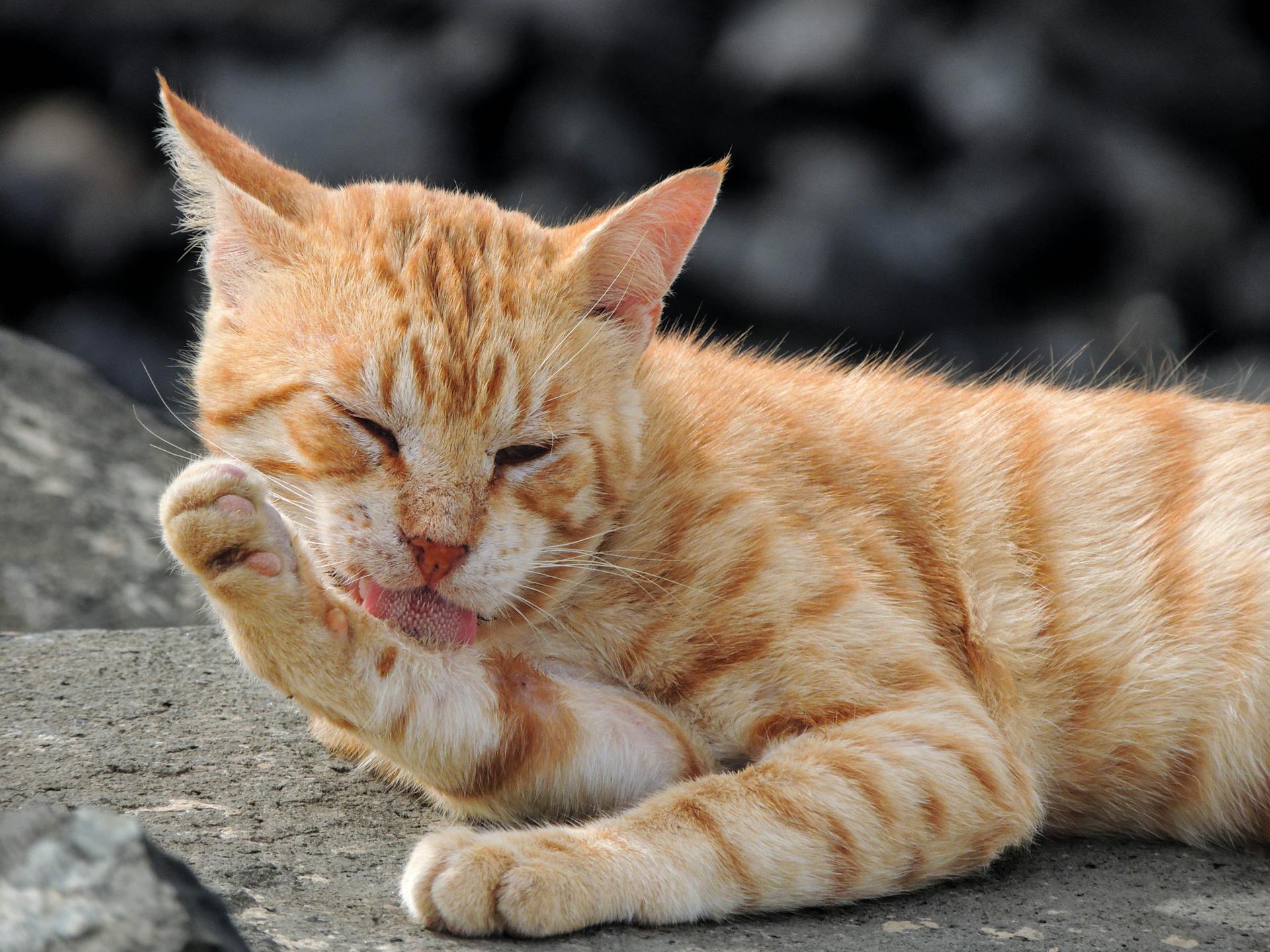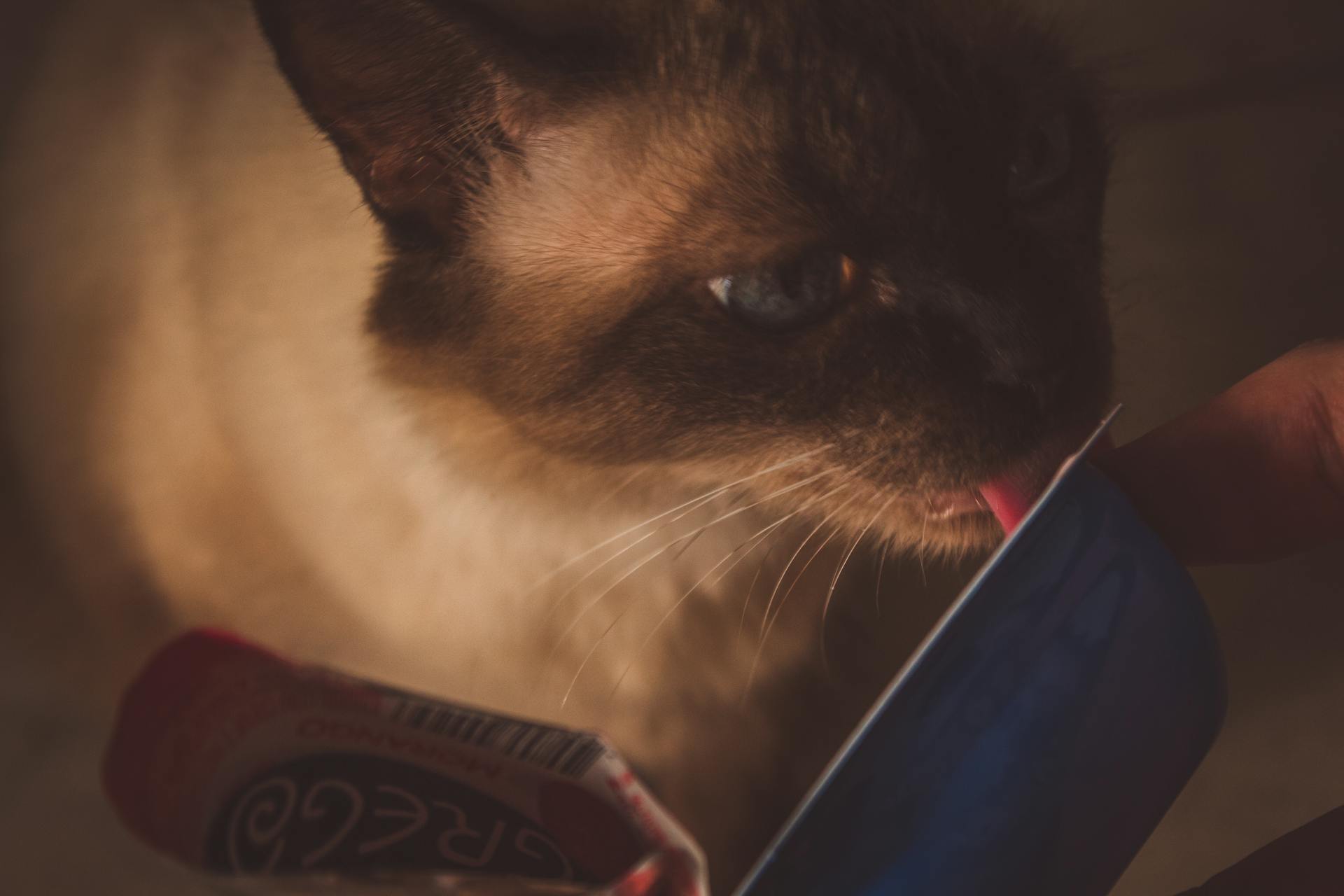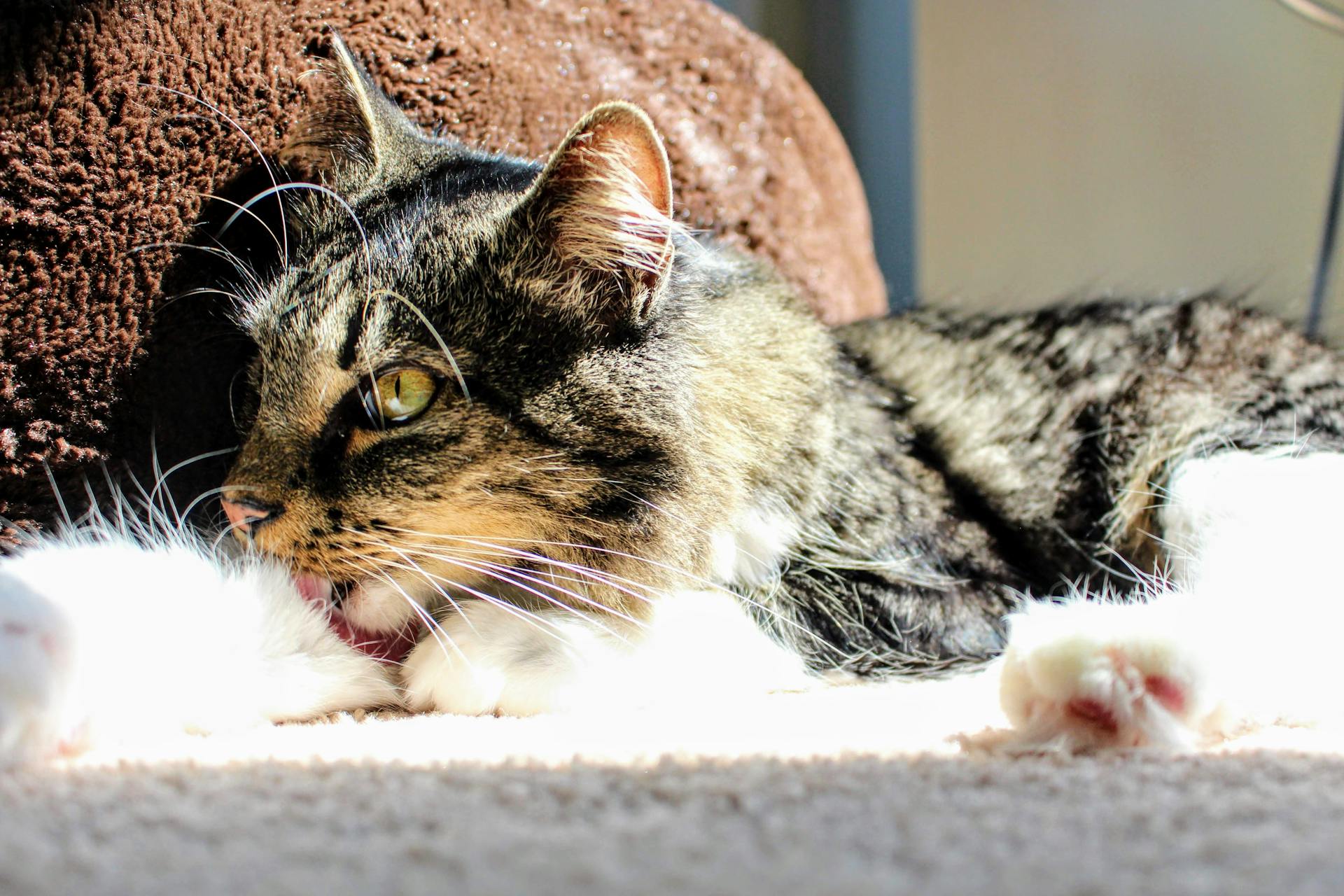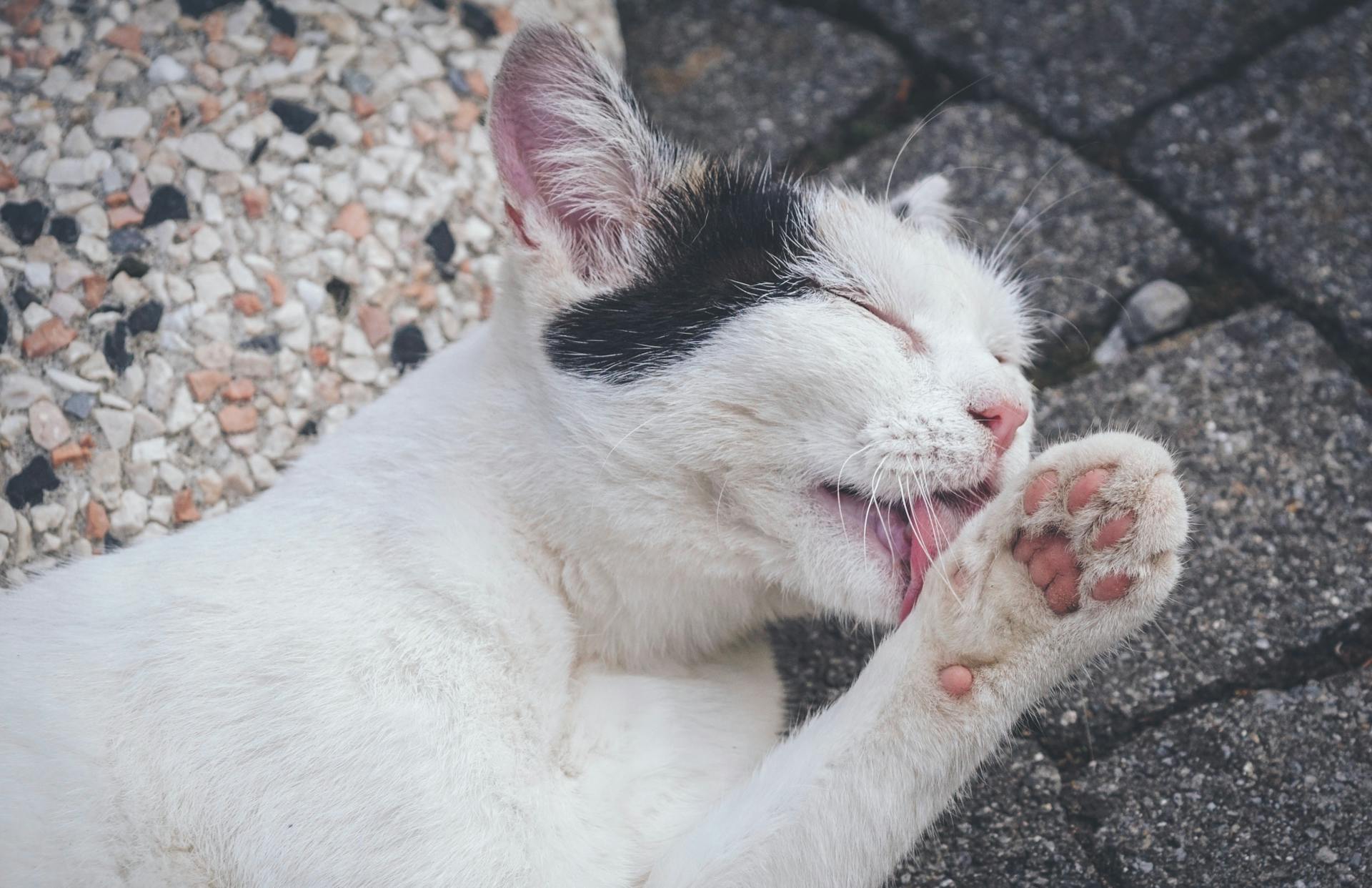
Lick granuloma and hotspots are two common skin conditions that can cause discomfort and distress for dogs. A lick granuloma is a localized area of skin inflammation caused by excessive licking, often resulting in a raised, hairless patch.
Excessive licking can be a sign of underlying anxiety or obsessive behavior in dogs. In some cases, lick granulomas can also be caused by allergies or skin irritations.
Hotspots, on the other hand, are a type of skin infection that can cause intense itching and discomfort for dogs. They often appear as red, swollen, and painful areas on the skin.
Hotspots can be caused by a bacterial infection, often Staphylococcus intermedius, which can spread quickly if left untreated.
See what others are reading: Can Allergies Cause Swollen Lymph Nodes in Dogs
Causes and Risk Factors
Lick granuloma and hotspots are two common skin issues that can drive you and your furry friend crazy. The causes of these conditions are often related, but not always the same.
Lick granuloma can be caused by allergies, behavioral issues, or a combination of both. It's not uncommon for dogs to develop a lick granuloma due to underlying conditions such as joint pain, infection, or minor irritants.
Suggestion: Canine Lick Granuloma
Physical causes of hotspots include joint pain, infection, allergies, and minor irritants. These conditions can lead to inflammation and secondary bacterial infections, which can cause your dog to scratch and lick the affected area.
Here are some common causes of hotspots:
- Allergies
- Boredom licking
- Ear infections
- Inflamed anal glands
- Poor grooming
- Swimmer's ear
- Trapped moisture from swimming or bathing
Dogs prone to lick granuloma and hotspots often share similar characteristics. Large breed dogs, such as German Shepherds and Golden Retrievers, are more susceptible to skin conditions and hotspots. If you suspect your dog has a lick granuloma or hotspot, it's essential to consult with your veterinarian to determine the underlying cause and develop an effective treatment plan.
Related reading: Lick Granuloma Treatment for Dogs
What Does It Look Like?
A lick granuloma can appear in different stages, but in the early phases, it typically looks like a well-defined wet spot with some redness and hair loss.
At first, it might resemble a type of skin infection known as moist dermatitis or a hot spot. However, as the licking continues, the granuloma can extend deeper into the skin, becoming deeply red or even eroded and ulcerated.

A lick granuloma often has distinct borders and an oval or round shape. Over time, it can become thickened as the body lays down scar tissue, and thick crusts and plaques can form over or around the granuloma.
The most commonly affected area is the distal forelimb, which is the part of the front leg close to the toes. This is where you'll typically find a lick granuloma, especially in large breed dogs.
Some breeds are more prone to lick granulomas, including Boxers, Doberman Pinschers, German Shepherds, Golden Retrievers, Great Danes, Irish Setters, Labrador Retrievers, and Weimaraners.
Here are some breeds that are most commonly affected by lick granuloma:
- Golden Retrievers
- Labrador Retrievers
- Doberman Pinschers
- Irish Setters
- Great Danes
Causes in Dogs
Excessive licking can be a sign of various underlying conditions in dogs. Allergies and behavioral issues are the two most common causes of lick granuloma, and often, dogs suffer from a combination of both.
Physical factors such as joint pain, infection, and minor irritants like bug bites or scratches can also contribute to lick granuloma.
Some common conditions that can cause hotspots in dogs include allergies, boredom licking, ear infections, inflamed anal glands, poor grooming, swimmer's ear, and trapped moisture from swimming or bathing.
The breeds most often affected by lick granuloma include Golden Retrievers, Labrador Retrievers, Doberman Pinschers, Irish Setters, and Great Danes.
Dogs may also develop lick granuloma due to underlying conditions such as irritation from bacterial or yeast infections, furunculosis, or ruptured apocrine glands, or even an infestation of skin mites.
Here are some of the physical causes of lick granuloma in dogs:
- Joint pain
- Infection
- Allergies
- Minor irritants (bug bites, scratches, etc.)
Testing
Testing for lick granuloma can be a process, but it's essential to rule out other conditions. Your vet may start with a fine needle aspirate (FNA) to collect cells from the affected area and examine them under a microscope.
A skin cytology or skin impression test may also be done to check for secondary bacteria infections, which 97% of lick granulomas will have. This involves scraping material off the skin lesion and applying it to a glass slide for examination.
Additional tests may be recommended, including skin scrapes to check for demodex mites, fungal cultures to rule out ringworm, and skin cultures to determine which bacteria are present and guide antibiotic choices.
Here are some common tests your vet might use to diagnose lick granuloma:
- Deep skin scrapings (to check for mites)
- Allergy testing
- Physical exam
- Skin cultures (to rule out skin infection)
- Skin biopsy (in rare cases to rule out cancer)
A skin biopsy may be necessary to confirm the diagnosis if there's no improvement after a few weeks of treatment. It's essential to work closely with your vet to determine the best course of testing for your dog.
Treatment and Prevention
Preventing hotspots and lick granulomas requires attention to your dog's overall health and hygiene. Regular baths, brushing, and haircuts can help keep mats from forming and skin healthy.
Treating allergy management, flea preventatives, and minimizing infections can reduce scratching and chewing, preventing further skin trauma. Good hygiene and regular coat care are essential, especially for dogs that swim and play outside.
Adding fatty acids to your dog's diet can help prevent hotspots and lick granulomas. Omega-3 fatty acids DHA and EPA found in fish oil have anti-inflammatory properties that can prevent and manage many canine skin problems.
Discover more: How to Help Dogs with Skin Allergies
To prevent lick granulomas, you need to deal with any obsessive licking at the first sign of it. Lick granulomas can develop within a matter of hours, so it's essential to keep an eye on your dog's behavior and skin.
Here are some steps you can take to prevent lick granulomas:
- Administer any prescribed medications as recommended by your vet.
- Work with your vet to create a bathing and grooming routine that helps remove surface allergens.
- Consider naturally calming treatments and supplements if your dog struggles with anxiety.
- Break out the E-collar or lick deterrents if you notice that your dog is just starting to lick an area.
Antibiotics
Antibiotics play a crucial role in treating lick granuloma, as the constant licking breaks down the skin's surface, allowing bacteria to migrate deeper and set up an infection.
Oral antibiotics are typically prescribed for six to eight weeks to combat these infections.
Topical antibiotics can also be extremely useful, and in some cases, they may reduce the need for systemic antibiotics, which in turn reduces the risk of antimicrobial resistance.
Long-acting topical ear medications like Claro can be used to treat lick granulomas, combining antibiotic, antifungal, and anti-inflammatory ingredients to treat the infection while providing itch relief.
Discover more: How to Stop Fading Puppy Syndrome
Topical Products
Topical products can be a valuable addition to your dog's treatment plan for lick granulomas. They can help reduce the need for systemic antibiotics and minimize the risk of antimicrobial resistance.
Some veterinarians use long-acting topical ear medications like Claro on lick granulomas. These products contain a combination of antibiotic, antifungal, and anti-inflammatory ingredients that can help treat the infection while providing itch relief.
Applying topical products regularly is key to their effectiveness. You may need to apply them every 8-12 hours to prevent your dog from licking the affected area.
Topical steroids like Synotic, which contain fluocinolone acetonide, can also be used to treat lick granulomas. These products are normally used for ear inflammation, but can be effective in reducing inflammation and itchiness in lick granulomas.
Dimethyl sulfoxide (DMSO) is sometimes included in topical products like Synotic to help the steroid move deeper into the tissues. This can help reduce inflammation and promote healing.
If you're considering using topical products, be sure to consult with your veterinarian to determine the best course of treatment for your dog. They can help you choose the most effective products and develop a treatment plan that works for your dog.
Broaden your view: Cat Licks Flea Treatment
At-Home
At-home treatment for lick granulomas can be a helpful addition to your veterinarian's recommendations. You can try using an E-collar, also known as the "cone of shame", to prevent your dog from licking the affected area.
There are other creative ways to deter licking, such as using socks or booties to cover a lick granuloma on a dog's paw. Just be sure to use ones that your dog can't chew or swallow.
If your veterinarian recommends it, you can also try using noxious topical products like Bitter Apple spray. These products taste awful, which can help discourage your dog from licking the area.
You can also try making your own homemade lick deterrents, but be sure to run them by your vet first to ensure they are safe. Generally, you'll need to apply the yucky tasting substance in small amounts every eight to twelve hours.
Here are some additional at-home tips to help prevent lick granulomas:
- Keep an eye on your dog's behavior and check for signs of obsessive licking, such as stained fur or sensitivity.
- Develop a habit of running your hands over your dog's body to check for damp fur or sensitivity.
- Check your dog frequently if you notice they're hiding or avoiding interaction.
- Lightly wrap the affected area in an athletic bandage to discourage further licking.
Frequently Asked Questions
Should I cover lick granuloma?
Yes, covering a lick granuloma with a protective device like an e-collar, bandage, or shirt may be recommended initially to prevent self-trauma while medication takes effect. This can help reduce discomfort and promote healing.
Are lick granulomas raised?
Yes, lick granulomas are typically raised, forming a well-defined skin nodule. This raised skin lesion is a result of repetitive licking and can become hairless, eroded, or ulcerated.
Sources
- https://www.scenthound.com/dogblog/how-to-identify-treat-and-prevent-hotspots-on-dogs
- https://toegrips.com/lick-granuloma-dog/
- https://vetericyn.com/blog/lick-granuloma-in-dogs-everything-you-need-to-know/
- https://www.dogsnaturallymagazine.com/licking-the-lick-granuloma/
- https://thekindpet.com/blogs/blog/how-to-treat-lick-granuloma-in-dogs-and-cats
Featured Images: pexels.com


